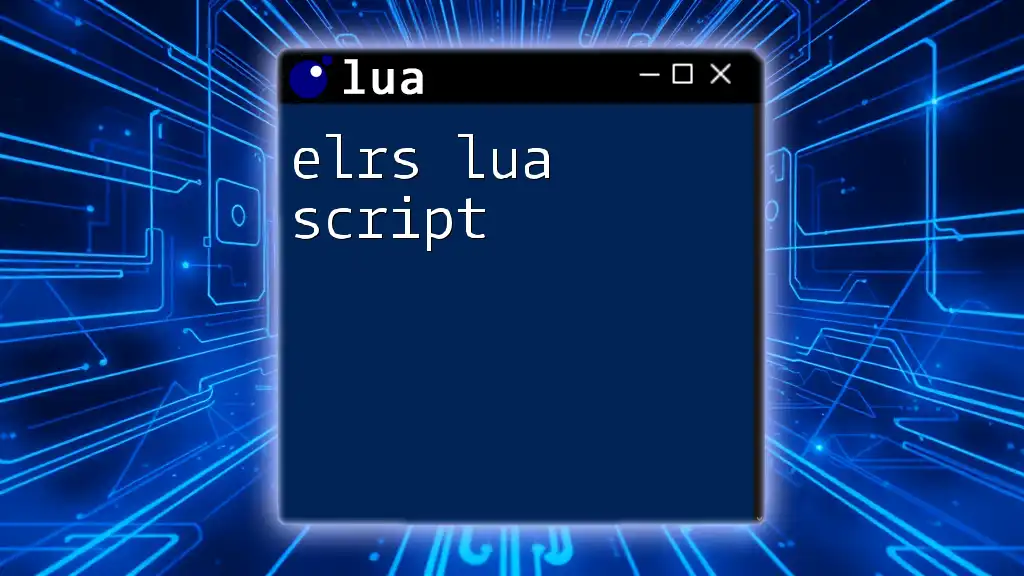The ELRS Lua script is specifically designed to interface with the ExpressLRS (ELRS) system, allowing users to control receiver settings and telemetry data using Lua commands within compatible transmitters.
-- Example of initializing a basic ELRS configuration in Lua
local elrs = require("elrs")
elrs.setProtocol("ELRS")
elrs.setFrequency(900) -- Set frequency to 900 MHz
elrs.setPower(100) -- Set output power to 100 mW
Understanding the Basics of LUA Scripting
Why Use LUA with ELRS?
Using LUA within the context of ELRS (ExpressLRS) offers significant benefits, primarily in terms of flexibility and customization. LUA scripting allows users to programmatically manipulate their devices, enabling a tailored flying experience. This customization includes setting up specific parameters for transmission power, channel selection, and other crucial variables for optimized performance.
Setting Up Your LUA Environment
To get started with ELRS LUA scripts, there are a few tools and steps needed to set up your environment. You’ll need:
- A compatible ELRS device (like a transmitter or module).
- LUA scripting capabilities integrated into your device or firmware.
Once you have your device ready, you typically install LUA scripts by copying them onto your device's storage. This involves accessing the firmware settings on the ELRS device and uploading the script files directly.

Essential LUA Commands for ELRS
Common LUA Commands and Functions
Several fundamental commands are often used when working with ELRS LUA scripts. These commands help configure and manage your device settings effectively. For instance:
print("Hello, ELRS World!")
This simple command outputs the message, allowing you to confirm that your LUA environment is set up correctly.
Setting up Device Parameters
LUA makes it straightforward to define and load specific parameters. For example, to configure the transmission power, you might use:
elrs.setTxPower(25) -- Set transmission power to 25 mW
This command instantly sets your device's transmission power, enhancing your control over its performance.

Creating Your First ELRS LUA Script
Step-by-step Guide to Scripting
When crafting your first ELRS Lua script, follow these steps to ensure that you cover all necessary components:
Initializing Your Script
Every Lua script begins with initialization. To initiate basic functionality in an ELRS environment, use the following code:
local elrs = require("elrs")
Configuring Basic Settings
After initializing, the next step is to configure your device’s basic settings. Each parameter has a specific command, and it’s essential to check the device’s documentation for available commands.
For example, to establish channel settings, you can use:
elrs.setChannel(5) -- Sets the channel to 5
Implementing Commands
With the basic setup in place, you can construct your script to implement various commands. Here are some examples:
elrs.setTxPower(100) -- Set transmission power to 100 mW
elrs.setChannel(1) -- Set channel to 1
elrs.bind() -- Bind the transmitter to receiver
These commands can be sequenced to carry out a complete setup in just a few lines of code.

Advanced ELRS LUA Scripting Techniques
Creating Functions for Custom Tasks
As you become more familiar with scripting, you may wish to create custom functions for common tasks. For instance, you might define a function to switch between different operational modes of your device:
function switchMode(mode)
elrs.setMode(mode)
end
This function facilitates easy transitions between modes, contributing to a smoother flying experience.
Utilizing Loops and Conditionals
Loops and conditional statements are crucial for implementing repetitive tasks and logic. An example of using a loop to check the device’s status might look like this:
for i = 1, 10 do
elrs.checkStatus() -- Execute status check 10 times
wait(1000) -- Wait for one second between checks
end
This loop efficiently checks the status of the device, allowing for timely responses during operation.

Debugging Your ELRS LUA Scripts
Common Issues and Solutions
Even experienced programmers encounter problems with scripts. Frequent issues may include incorrect parameter values, improper function calls, or syntax errors.
To effectively troubleshoot, it’s helpful to refer to error messages carefully and ensure that your code structure aligns with LUA standards.
Using Print Statements for Debugging
Incorporating print statements into your script is a straightforward way to monitor its performance. For example, to track your device’s current mode, you could implement:
print("Current mode: ", elrs.getMode())
This provides a real-time output of the device’s current operating mode, simplifying the debugging process.

Best Practices for ELRS LUA Scripting
Writing Clean and Efficient Code
When scripting, clean and efficient code is essential. This not only improves readability but also minimizes the risk of errors. Aim for consistent indentation and naming conventions in your functions and variables.
Documentation and Comments
Documenting your code is vital, allowing you to reference your thought process in the future. Use comments throughout your code to clarify the purpose of specific commands and functions:
-- Set the transmission power to the maximum limit
elrs.setTxPower(100)
This practice enhances both personal understanding and future collaborations with fellow programmers.

Resources for Further Learning
Online Tutorials and Forums
There’s a wealth of resources available online for learning ELRS and LUA scripting. Community-focused websites and forums, such as GitHub and Reddit, often host discussions, tutorials, and troubleshooting tips shared by users passionate about this technology.
Books and Documentation
Consider exploring books dedicated to LUA programming and ELRS functionalities. Official documentation provides essential insights that can significantly accelerate your learning curve.

Conclusion
In summary, utilizing ELRS LUA scripts allows for an enriched experience with greater control over your equipment. With the ability to create custom settings and commands through easily understandable LUA scripts, you'll find that your flying or racing experience becomes increasingly enjoyable and sophisticated.
As you delve deeper into the world of ELRS scripting, don’t hesitate to experiment with different commands and functions. The beauty of LUA lies in its flexibility and the vast capabilities it affords you in personalizing your RC equipment.

















